|
Centrip Editorial Board
Check out Nagoya Castle's Honmaru Goten!

Table of Contents
- Past, Present, and Future of Honmaru Goten
- Honmaru Goten, Let's Start!
- Omoteshoin Area: All visitors were granted an audience with the lord here.
- Taimenjo Area: A private meeting place.
- Joraku-den Area: Gorgeous! Exclusive Area for Shogun.
- Don't miss the small treasures
- Multiservices: Going through each place in order
- Notice
- Wrap-up
When it comes to sightseeing in Nagoya, most people think of Nagoya Castle. Nagoya Castle's Tenshukaku (天守閣-keep) has been closed since 2018 for restoration, but the luxurious Honmaru Goten (本丸御殿-Main Palace) is still open to everyone!
This time, Centrip presents a detailed explanation of the Honmaru Palace, its highlights, and the multilingual services available. With this article, you will learn all about the Honmaru Palace, and won't miss any of the sights!
Past, Present, and Future of Honmaru Goten
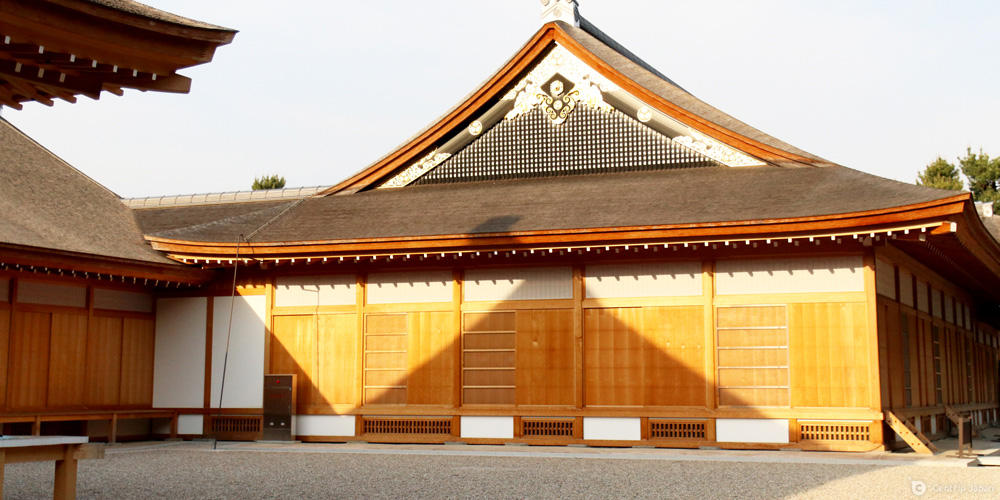
Honmaru Goten was built in 1615 as a residence for Tokugawa Ieyasu (徳川家康- The first Shogun of the Tokugawa Shogunate) and his 9th son, Yoshinao and his family.
Five years later, Yoshinao and his family moved to the Ninomaru Goten (二の丸御殿-Ninomaru Palace) but Ieyasu continued to live in the Honmaru Palace. After the Meiji Restoration, Nagoya Castle was transferred to the division of Kunaisho (宮内省-Imperial Household Ministry) and called Nagoya Rikyu (名古屋離宮-Nagoya Rikyu). It was designated as one of Japan's first national treasures in 1930 and was gifted to Nagoya City.
Honmaru Goten has many Kano School (狩野派/Kano ha) wall paintings and gorgeous metal fittings and has gone down in history for its architecture, painting, and arts and crafts.
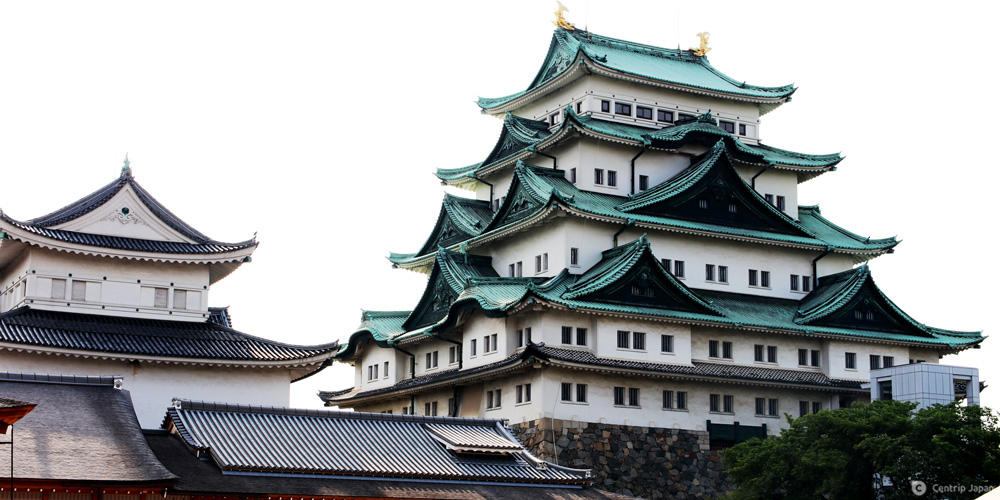
When people think about Japanese castles, the first thing that comes to mind is the keep. In actuality, it is only a part of the castle in addition to the Honmaru Goten. The keep is used as a military facility and the Goten is a living space.
The name of the Goten differs depending on the location; Honmaru Goten has been given this name because it is located in the Honmaru area.

Unfortunately, Nagoya Castle was destroyed by airstrikes in 1945 and lost its original keep as well as the Honmaru Goten.
However, the measurements and photographs taken in the early Showa era were recovered, and the wall paintings were also taken to store in other places before the airstrikes. Since 2009, Nagoya City has begun to restore the Honmaru Goten, and after nine and a half years it was finally finished in 2018.
Thanks to recovered rare historical materials, Honmaru Goten has been completely restored from the exterior, down to the smallest parts. As such the Honmaru Goten we are looking at now is nearly identical to the one Tokugawa Ieyasu saw 400 years ago!
Honmaru Goten, Let's Start!

The Honmaru Palace is made entirely of cypress, in the traditional Shoin-style (書院造り/Shoin-zukuri) of building in Japan.
The Shoin-style is an architectural style developed between the Muromachi and early Edo periods, built mainly with the Shoin (書院/Shoin-a living room with a study) used to see and serve customers. Here are the three areas of the Honmaru Palace according to the room's functions.
Omoteshoin Area: All visitors were granted an audience with the lord here.

Omoteshoin Area (表書院/Omoteshoin) includes Nakanoguchi (中之口/Nakanoguchi) room, Tamarinoma (溜之間/Tamarinoma), and an entrance hall (玄関/Genkan-Entrance Hall connected by a large hallway) and it was used as an official room for meeting the lord. There are many things to see in the entrance hall and Omoteshoin.
Nakanoguchi room: Where the chief retainers met.
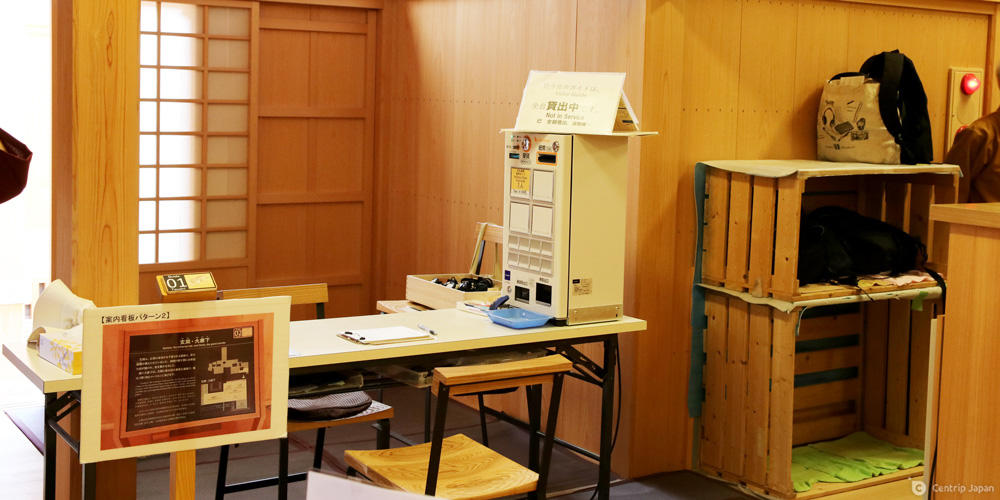
Nakanoguchi room (中之口/Nakanoguchi) is the first place to step in after entering Honmaru Goten. As soon as you get in, you will notice that the room is filled with the scent of cypress.
It was originally a meeting place for chief retainers but now used as part of the entrance. Shoe lockers, free storage lockers, a reception, and multilingual service reception are all available here. Leave your heavy baggage in the locker here and go see Honmaru Goten!
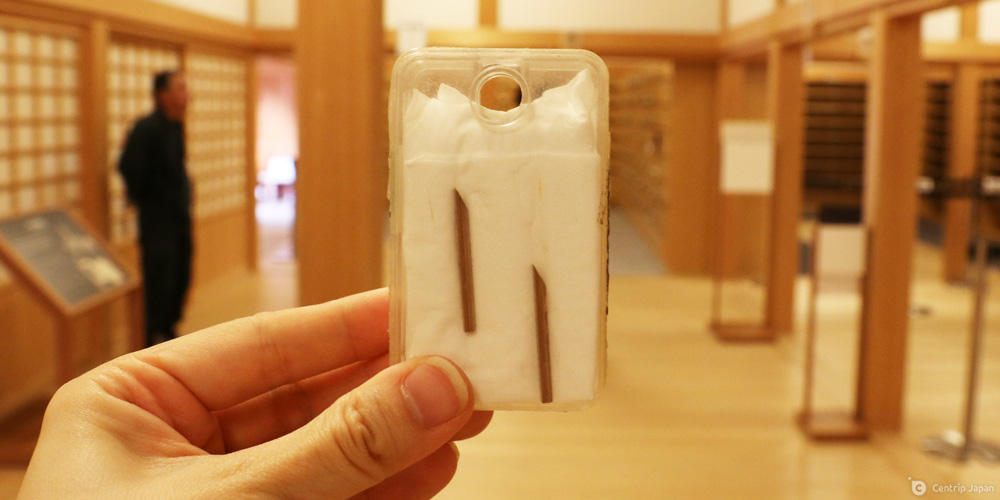
Tip: If you ask the receptionists, they will show you the nails used for building this Palace.
Entrance Hall: Waiting area
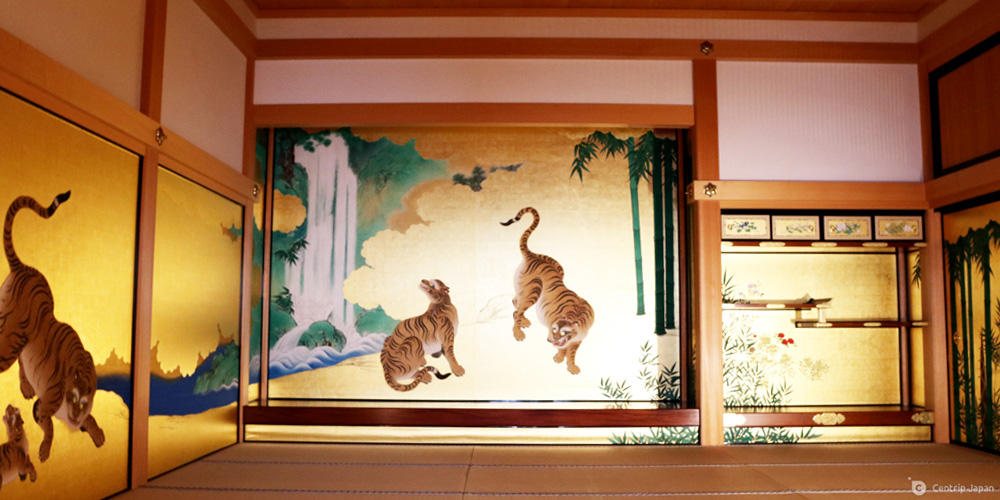
In the past, when you came to see someone at Honmaru Goten, the first place you are allowed to enter is the entrance hall (玄関/Genkan-Entrance Hall), the current entryway.
In the entry hall, there are two rooms where you will wait to see the lord of the castle. Here, you can see a Golden wall painting. Chikurin Hyoko Painting (竹林豹虎図/Chikurin-Hyoko Zu-Bamboo, forest, leopard and tiger painting) conveys the solemnity of the lord to visitors.
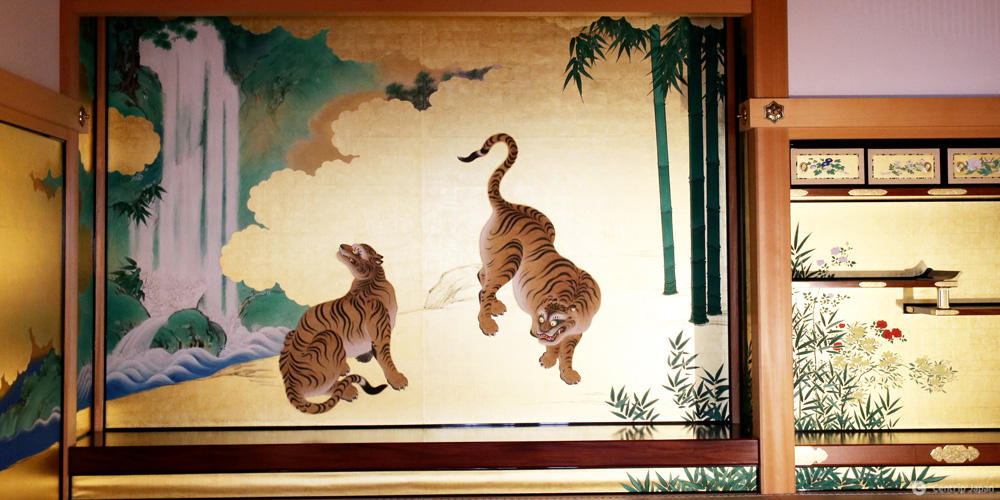
There is an interesting story behind this folding screen painting. There are two animals, a panther and a tiger, in the painting, but the painter did not originally intend to draw two. Back then, there were no tigers in Japan. All the images of tigers came from pictures or writings from Korea or China and therefore, people used to believe that leopard were female tigers. So, what was actually drawn in Chikurin Hyoko Painting is a "happy tiger family!"
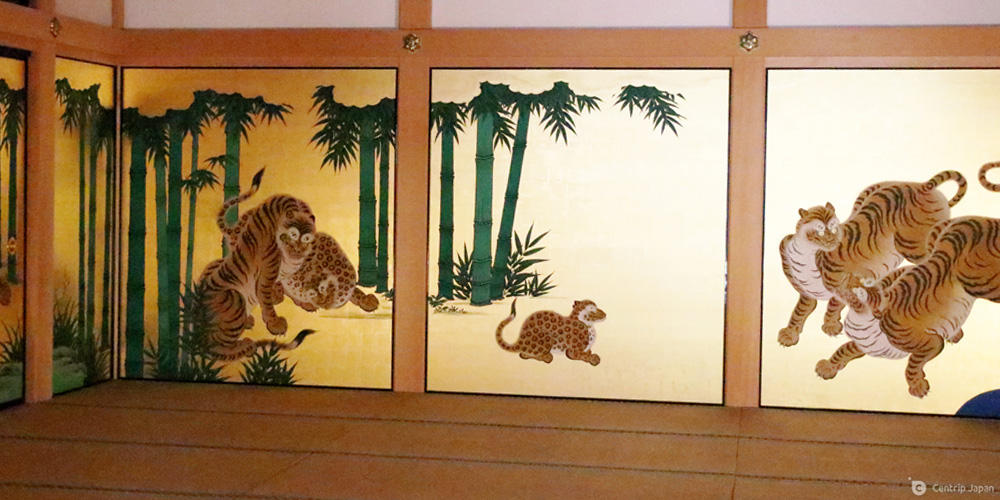
Tip 1: A special exhibition is held on an irregular basis, the authentic Chikurin Hyoko Painting with a history of more than 400 years, will be returned to its original place. If you want to see the real painting, check the exhibit schedule in advance.
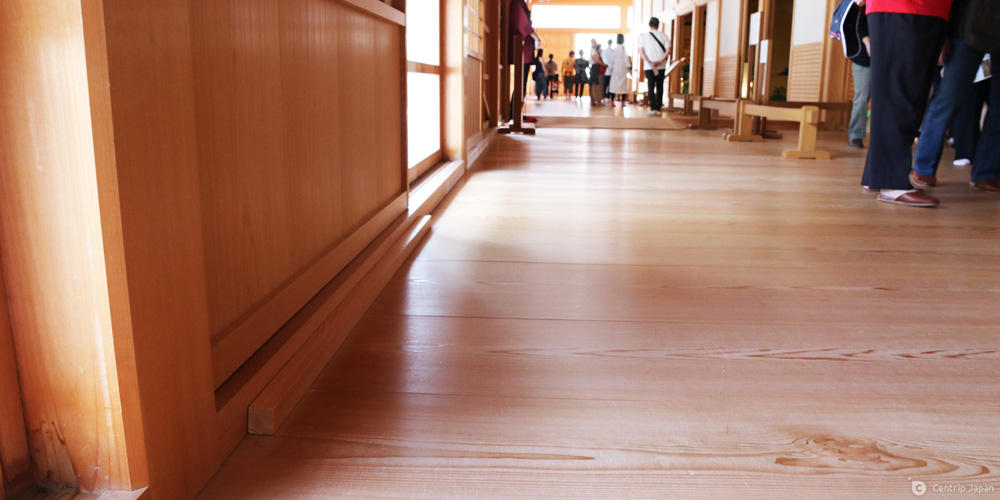
Tip 2: A large corridor connects hallway and Omoteshoin (表書院/Omoteshoin) . The width of the cypress foor piece is about 30 centimeters long and this single piece is worth as much as a Mercedes.
Omoteshoin: Where visitors officially met the lord.
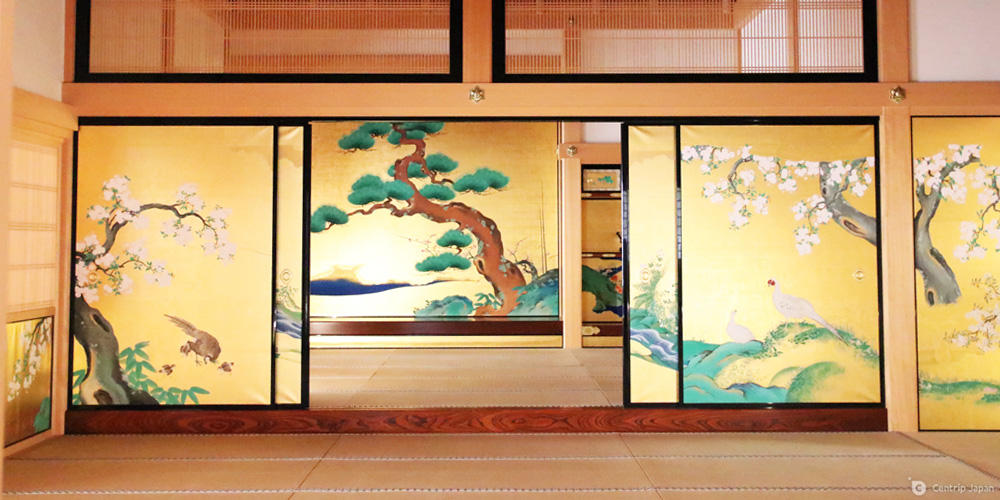
During the Edo period, Omoteshoin was called Hiroma (広間/Hiroma) an area where the servants or visitors were granted an audience to the lord. There are four rooms.
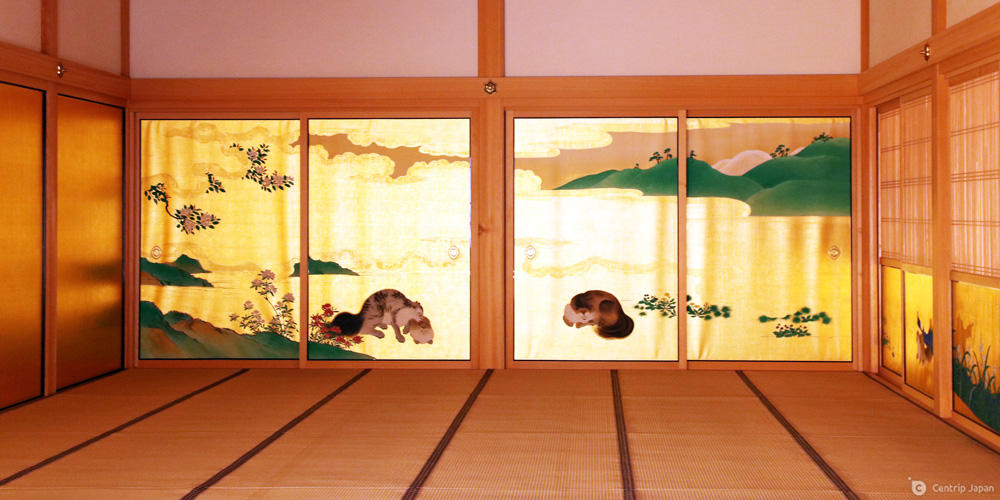
First, you will see Sanno-ma(三の間). Here, a civet cat is drawn on a folding screen. It sits in front of the water, next to flowers like azaleas. Depicting typical Japanese summer scenery.

At Ichino-ma(一の間), you'll see Ouka-kijizu (桜花雉子図/Ouka-kijizu). It depicts Pheasants playing under fully bloomed cherry blossoms in Spring, symbolizing a wish for family prosperity.

Further in is the most prestigious room in Omoteshoin, Jodanno-ma(上段の間/Jodanno-ma-room with a raised floor). Evergreen pine trees have been drawn, symbolizing longivity. What differs this from other rooms the Chodai-gamae (帳台構-the entrance to the bedroom) in the upper area, which is formal room decoration, displaying the power of the lord.
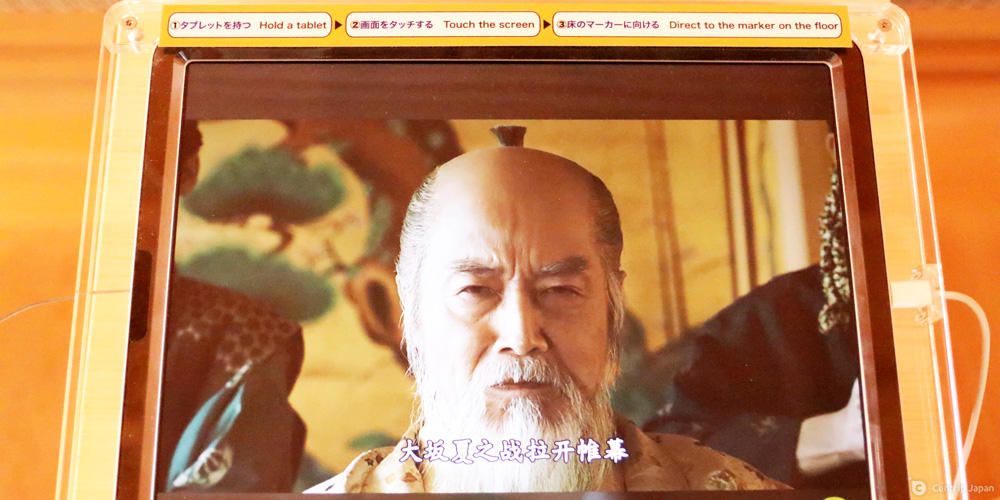
Tip: There is AR equipment in front of Ichino-ma, which shows the official meeting of Ieyasu and Yoshinao in Omoteshoin before Osaka Natsuno-Jin (大阪夏の陣-The Siege of Osaka was a series of battles undertaken by the Tokugawa shogunate against the Toyotomi clan, which ended in the clan's destruction.) Here, you will realize that Honmaru Goten is not only a majestic place, but also a place of historical importance.
Don't worry if you can't understand Japanese, the AR has subtitles in English, Chinese, and Korean. If you are visiting in a group, you can scan the QR code next to the AR equipment to show you the same content as the AR.
Taimenjo Area: A private meeting place.
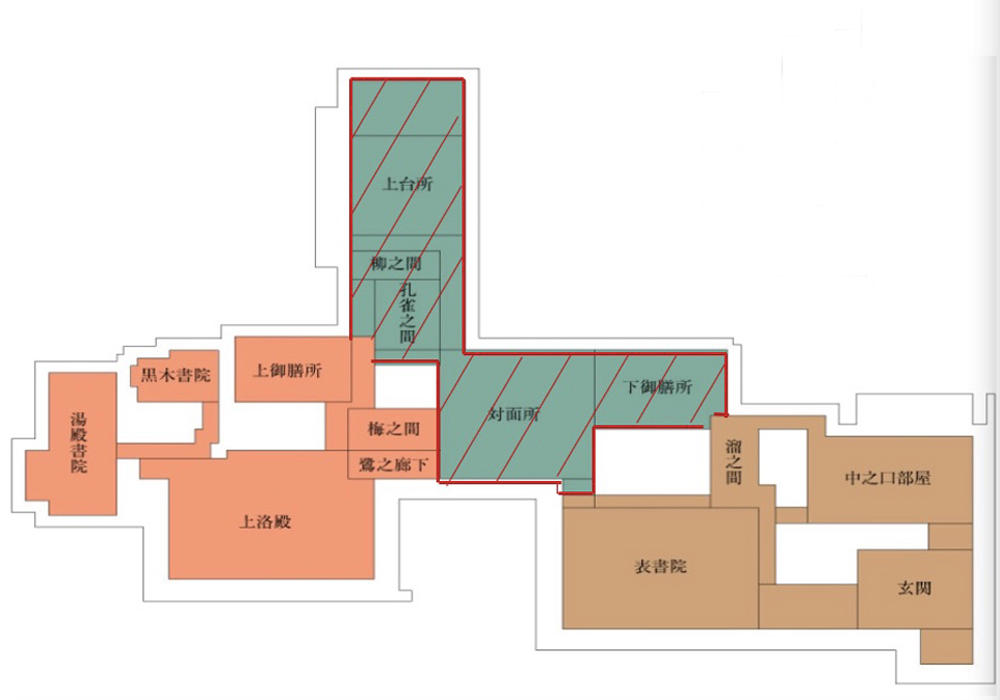
Compared to Omoteshoin, Taimenjo area (対面所/Taimenjo) is more private and used for the lord to meet his family and servants, or parties. The wedding of Tokugawa Yoshinao (徳川義直/Tokugawa Yoshinao-Ninth son of Tokugawa Ieyasu), the first lord of Owari (尾張/Owari-and old province in Japan in current day Aichi prefecture) and Haruhime (春姫/Haruhime-wife of Tokugawa Yoshinao) was held here. The room itself is luxurious and classic compared to Omoteshoin.
Taimenjo Area includes Shimogozenjyo (下御膳所/Shimogozenjyo), Kujyakunoma (孔雀之間/Kujyakunoma), Yanaginoma (柳之間/Yanaginoma), and Kamidaidokoro (上台所/Kamidaidokoro).
Taimenjo: Where the lord's wedding was held.
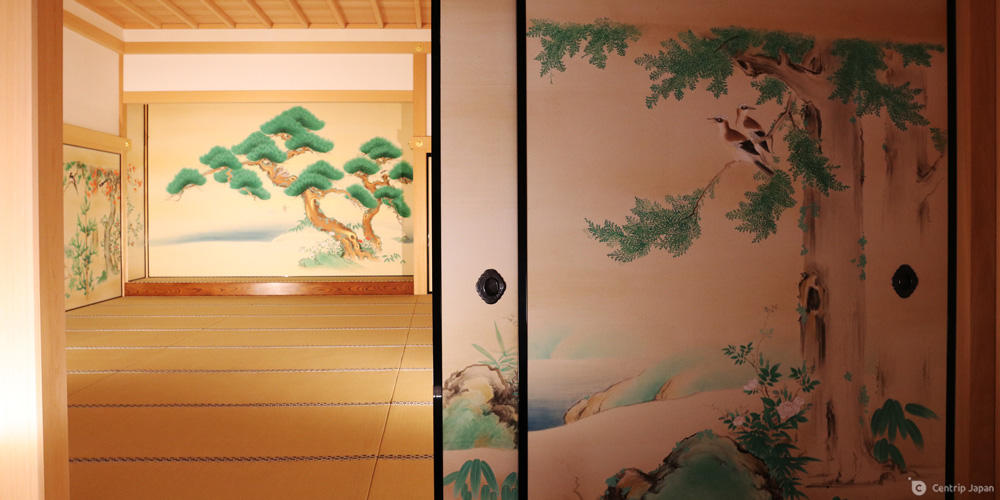
Following the palace route, the next places are the Nando-ichinoma (納戸一之間/Nando-ichinoma-first storeroom) and Nando-ninoma (納戸二之間/Nando-ninoma-second storeroom). Both rooms are decorated with Sansui-Kacho Zu (山水花鳥図/Sansui-Kacho Zu-mountain, water, flower, and bird painting).
The Nando-ninoma is the only room you can actually enter. Most of the Shouji (障子-Japanese Paper Doors) are removed for better visibility, which makes it feel like it isn't a room.
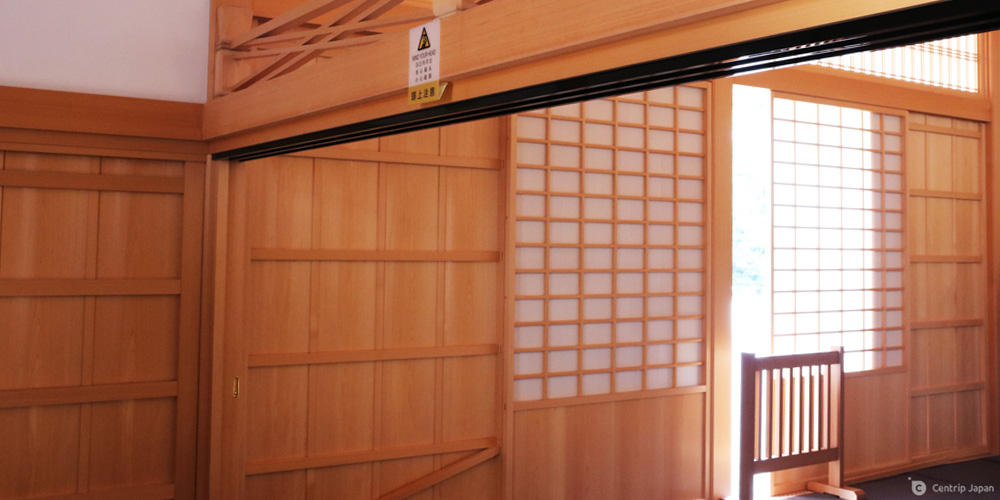
There are Shouji at the lower area of the room where Omotshoin and Taimensho connect. Now those Shouji are gone, too. lol Warnings in upper areas instruct visitors not to enter the room without permission.
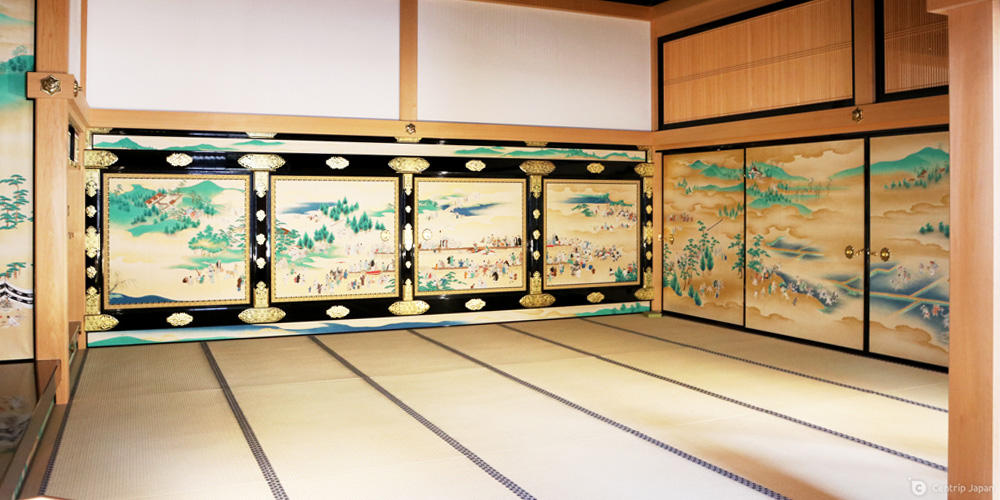
Tokugawa Yoshinao and Haruhime were said to have been wed at Taimenjo Jodan-no-ma and Tsugino-ma. Yoshinao was 15 years old and Haruhime was 13 years old.
The painting in the Jodanno-ma depicts Yoshida Shrine and Kamigamo Shrine in Kyoto that have ties with the Tokugawa family. Yudate Shinji at Yoshida Shrine and traditional activities such as Kamo's horse racing at Kamigamo Shrine in May are depicted in the painting.
*Yudate Shinji: a shrine maiden dips a bamboo leaf in the boiling water in a large pot in front of the gods, then sprinkles it on people's body to pray.

Painted in Tsuginoma is the birthplace of Haruhime; Wakano-ura. A salt making and ship festival symbolizing the prayer for the harvest in autumn.
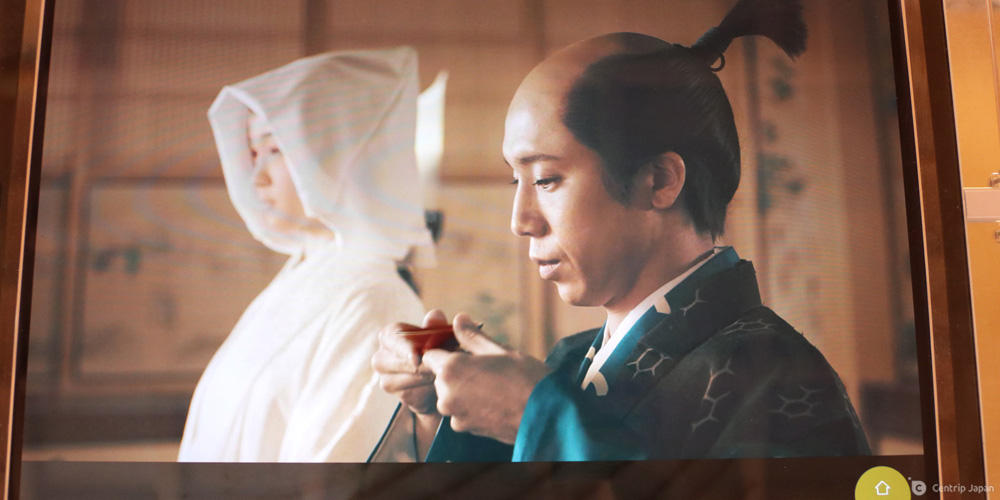
Tip: AR is available near Jodanno-ma. You can see the wedding of Yoshinao and Haruhime. There is also a QR code mobile phones.
What's buggin me is that 15-year old Yoshinao and 13-year old Haruhime seem way too mature for their age...
Joraku-den Area: Gorgeous! Exclusive Area for Shogun.
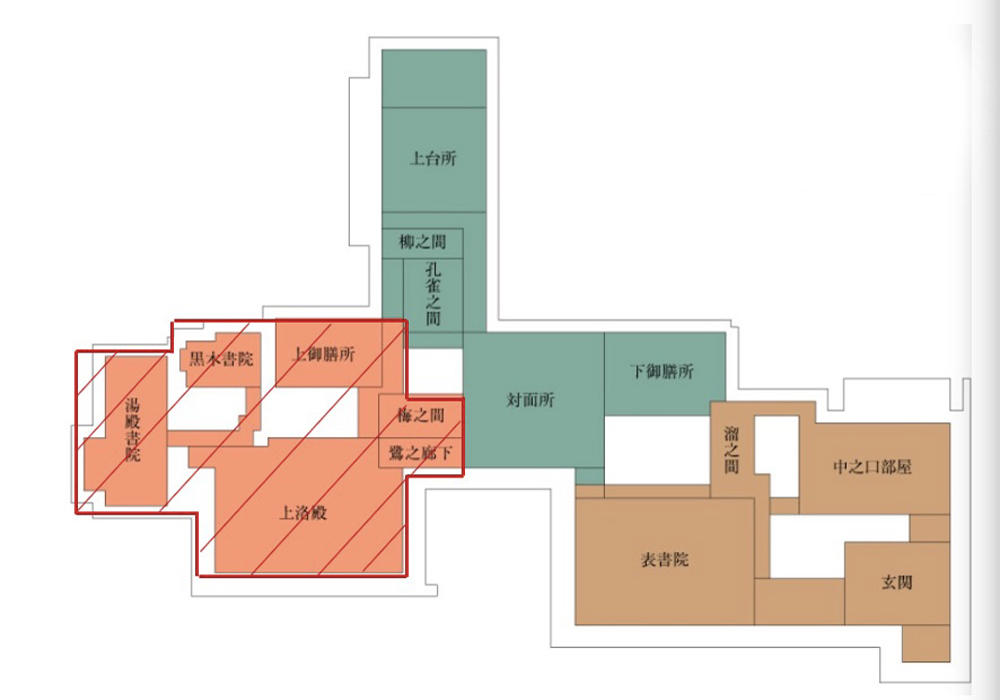
Joraku-den Area was buit as a stayover location for Tokugawa Iemitsu, the the third Shogun, when visiting Kyoto. Because Joraku means going to Kyoto, this area is called Joraku-den.
Joraku-den Area includes Sagino-rouka, Joraku-den, Umeno-ma, Jogozenjo, Yuden-shoin, and Kuroki-shoin. Since Yuden-shoin and Kuroki-shoin have limited space, you can only enter when you take a guided tour.
Sagino-rouka
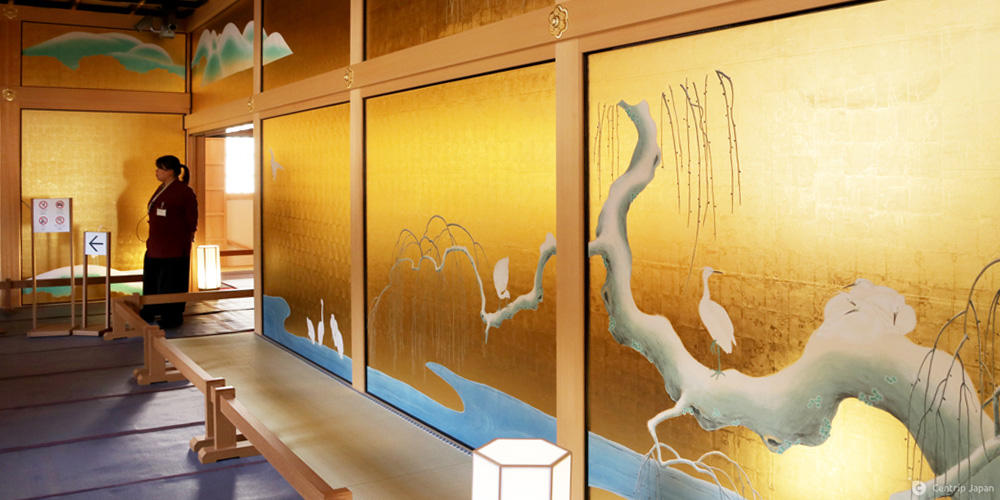
Jorakuden Area starts with Sagino-rouka. It is a space exclusively for the Shogun. Here, a winter scene is depicted, with a heron and a willow, reeds covered in snow.
Starting here, the screen will look wider and the decoration of the room feels more luxurious.
Joraku Den: A Place for the Shogun
There are four rooms here; Sanno-ma, Nino-ma, Ichino-ma, and Jodanno-ma. This room is gorgeous and sumptuous, suitable for a Shogun.

The four-screen-drawing in Sanno-ma shows Shiki-Kacho zu (四季花鳥図-four seasons with flowers and birds). The seasons are described anti-clockwise. The first thing you can see is the Sanbe Matsuki Zu on the west side. It depicts a summer landscape, where next to a pine tree, a waterfall flows, and a heron rests quietly.

The decorations of Joraku-den are strongly influenced by traditional Chinese culture. A lot of birds are carved on the overhead decorations in Nino-ma. Among those birds, one of them is standing on a drum. This drum was supposedly at the old Chinese government office.
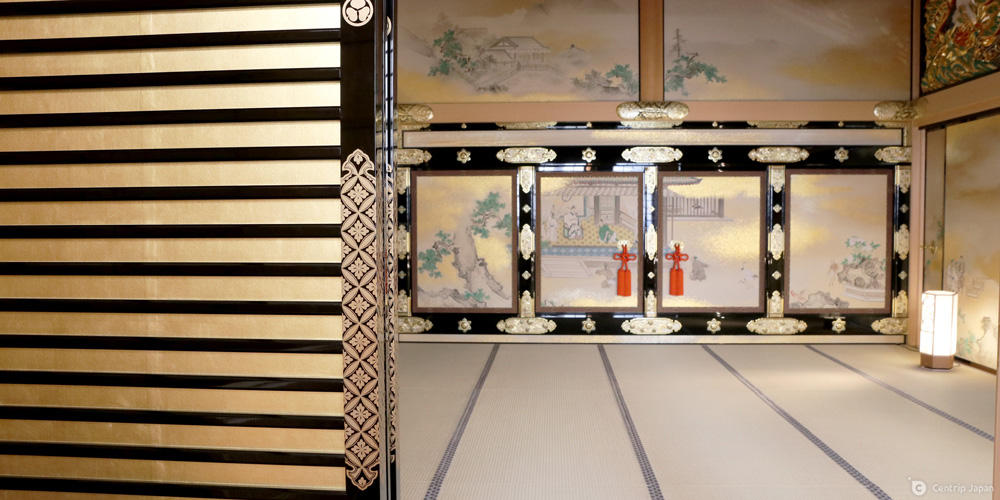
Teikanzu (帝鑑図-the emperor's history) that is drawn in the wall painting in Ichino-ma and Nino-ma. This comes from Teikanzu-setsu, a story of good and bad emperors of China, written by the Chinese Ming Dynasty politician Zhang Juzheng. Actually, Teikanzu-setsu is the subject of the paintings that the Kano school has been adopting. In Jorakuen, they only chose good emperors.


Umeno-ma: A resting room for senior servants

Umeno-ma is a resting place for the senior servants. The name comes from Sechu-roubai zu (雪中老梅図-the old plum tree in the snow) decorated in the room.
Kamigozenjyo & Shimogozenjo: to heat up the food

Kamigozenjo & Shimogozenjo are the places where people would heat up or plate food. (They don't cook here, though.) Kamigozenjo is in charge of the food at Joraku-den.
The cypress wood that was used to restore Honmaru Goten and how it was restored are written on the signboard here.
Don't miss the small treasures
When you are going through Honmaru Goten, you are probabley feeling how great the wall paintings are. But there are many more other things to look at!
Ceiling
Depending on the grade of the rooms, there are many different styles of the ceilings. When you are in the room, do not forget to look up!
 Kogumigotenjo (Omoteshoin Ichino-ma)
Kogumigotenjo (Omoteshoin Ichino-ma)
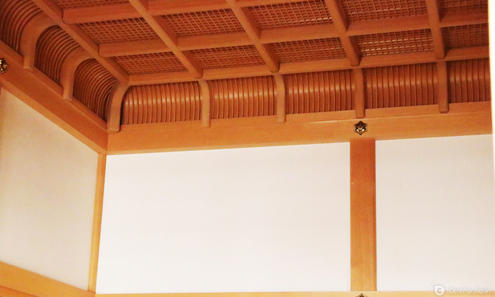 Oriage-Kogumigotenjo (Omoteshoin Jodanno-ma)
Oriage-Kogumigotenjo (Omoteshoin Jodanno-ma)
 Kurourushinuri Niju Oriage Kogumigotenjo (Taimensho Jodanno-ma)
Kurourushinuri Niju Oriage Kogumigotenjo (Taimensho Jodanno-ma)
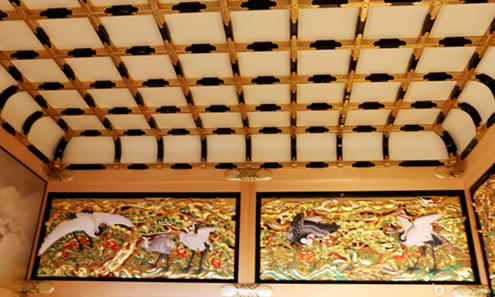 Kintsujigu (Jorakuen Ichino-ma)
Kintsujigu (Jorakuen Ichino-ma)
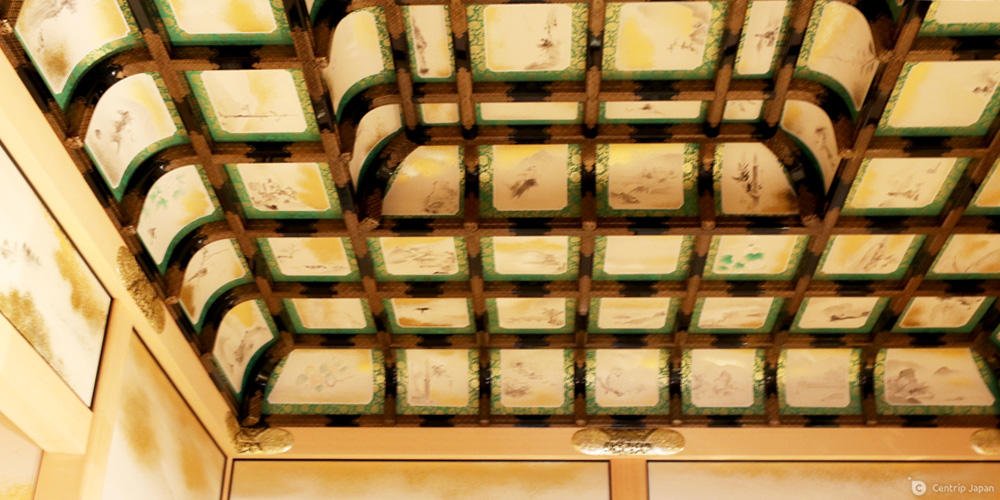 Tenjo-e (Jorakuen Ichino-ma)
Tenjo-e (Jorakuen Ichino-ma)
Kazari Kanagu
Pretty Kugikakushi (釘隠-nail covers) and Hikite (引手-a door handle) are like decorations are in the room. Similar to the ceilings, there are differences depending on the grade of the room.
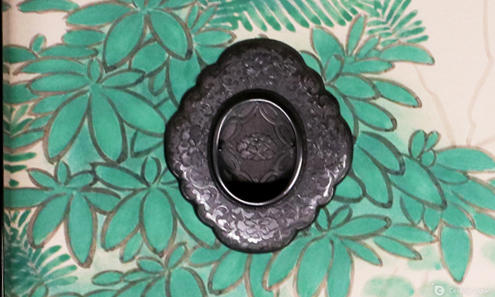 Hikite Kanagu (Taimensho Nanndo Ninoma)
Hikite Kanagu (Taimensho Nanndo Ninoma)
 Hikite Kanagu (Jorakuden)
Hikite Kanagu (Jorakuden)
 Hikite Kanagu (Kuroki Shoin)
Hikite Kanagu (Kuroki Shoin)
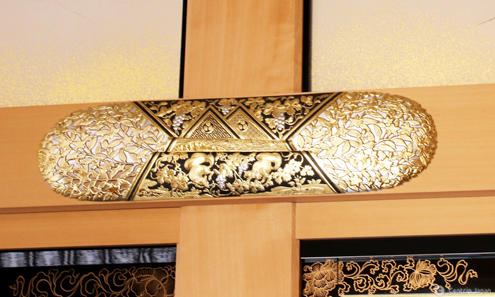 Kagikakushi (Jorakuden)
Kagikakushi (Jorakuden)
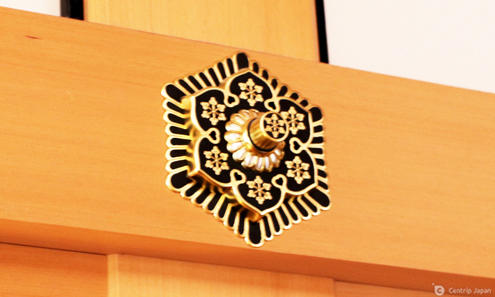 Kagikakushi (Yuden-Shoin)
Kagikakushi (Yuden-Shoin)
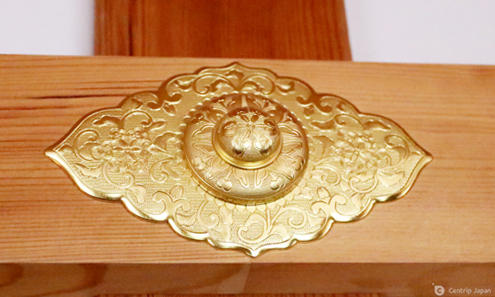 Kagikakushi (Kuroki-Shoin)
Kagikakushi (Kuroki-Shoin)
Multiservices: Going through each place in order
At Honmaru Goten, they offer mulilingual services in Japanese, English, Chinese, and Korean. You don't need to worry even if you don't understand Japanese. Ramps are available in every room except Yuden-shoin and Kuroki-shoin for the disabled.
Multilingual Sound Service
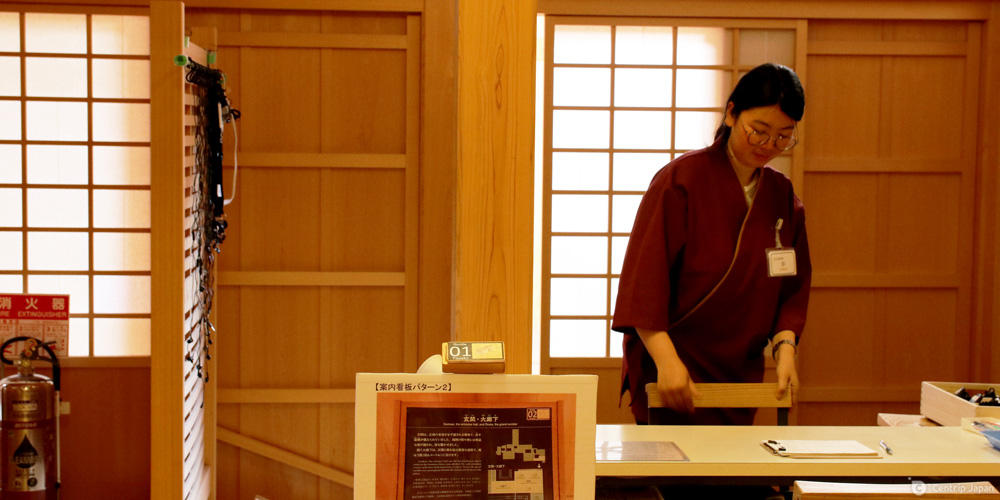
The entrance of Honmaru Goten (Nakanoguchi room) provides multilingual sound rental service (Japanese, English, Chinese, and Korean). It only costs ¥100 per equipment. By using this service, you will have lot more information compared to just reading signboards.
Multilingual Guide Course: Yuden-Shoin and Kuroki-Shoin
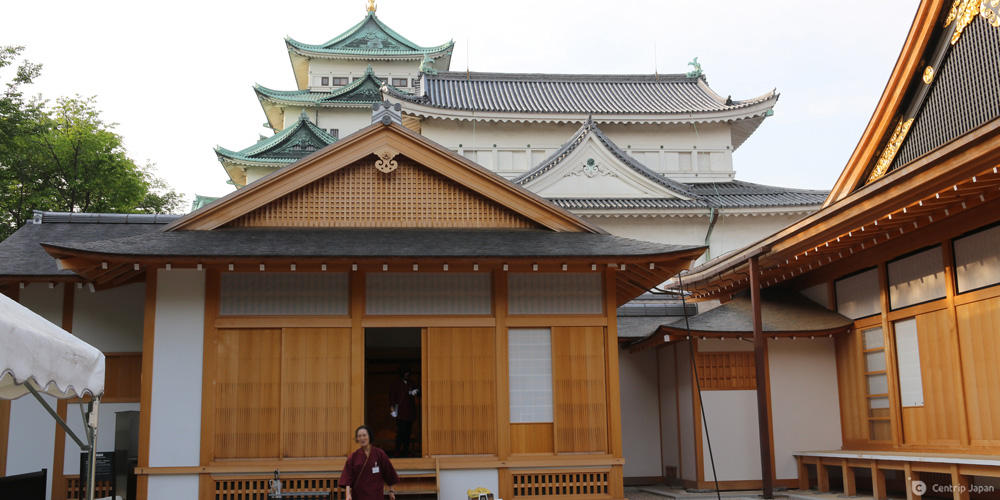
Yuden-Shoin and Kuroki-Shoin are used by the shogun to bathe or rest. You can only enter here with on a guided course.
A multilingual guide course is held on a regular basis every day. Choose Japanese, English or Chinese courses. Each language has a different schedule, and the group size for each tour is limited to 15. At Yuden-Shoin, you can get a numbered ticket depending on the time and language you chose.
Multilingual Guide Course is free.
Notice
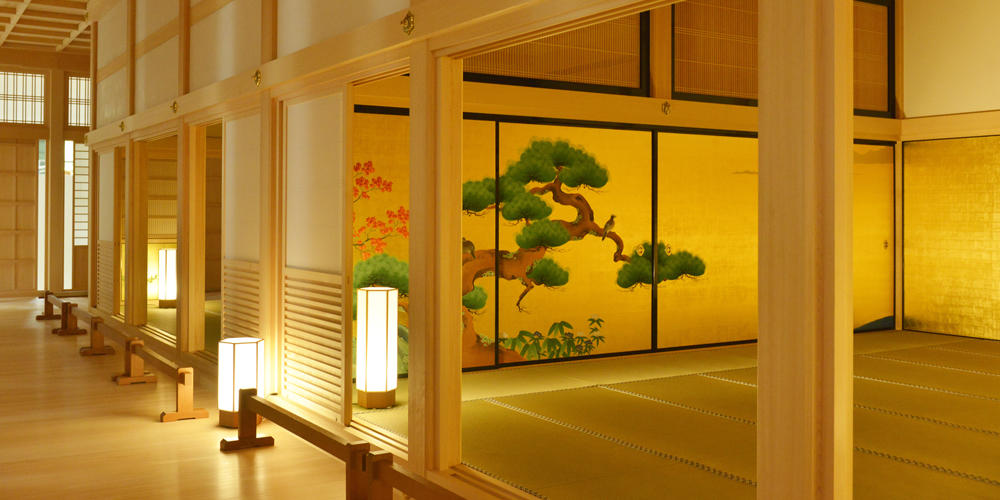
When you go about Honmaru Goten, there are several things you should keep in mind: Do not touch the building. Do not use the flash when taking photos. Do not eat & drink. Do not use your phone. Do not bring pens. Place your belongings or baggage in front of you.
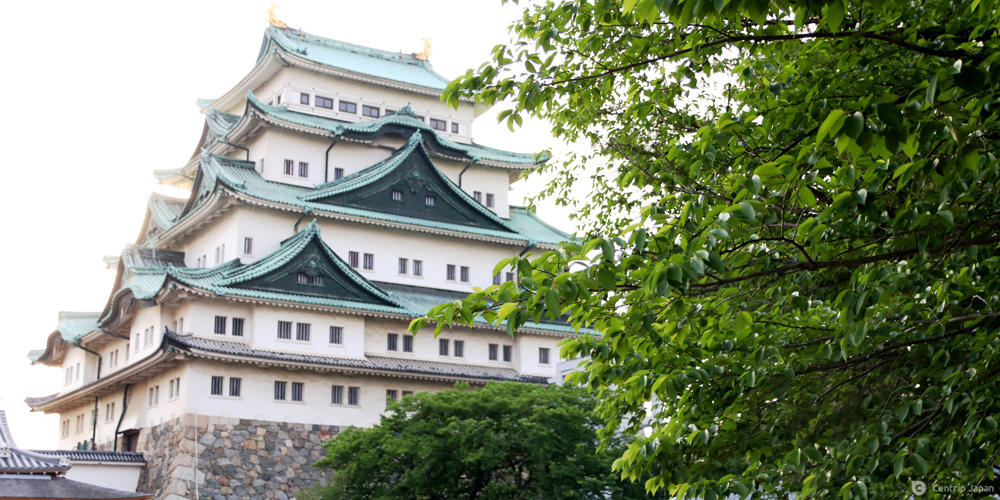
There is one more thing you should know. You cannot go to the keep from Honmaru Goten. They are built independantly. The keep has been closed since 2018, and it will reopen in the end of 2022. Let's wait until then!
Wrap-up
Are you up for visting Honmaru Goten?
Honmaru Goten is not just a bunch of rooms. This is a supreme art collection of the best craftspeople and painters in Japan! Come and visit here so that you won't regret it. There are so many hidden treasures to look at in the palace. With this guide, see the extreme beauty and luxury of the Shogun for yourself!

